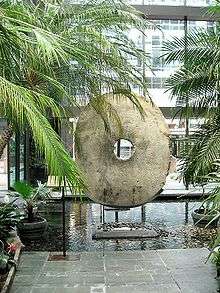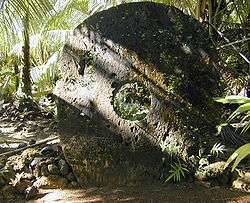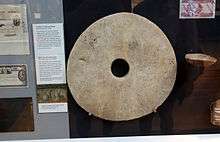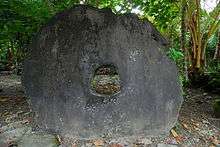Rai stones



Rai, or stone money (Yapese: raay[2]), are large, circular stone disks carved out of limestone formed from aragonite and calcite crystals.[3] Rai stones were quarried on several of the Micronesian islands, mainly Palau,[4] but briefly on Guam as well, and transported for use as money to the island of Yap. They have been used in trade by the Yapese as a form of currency.
While the monetary system of Yap appears to use these giant stones as tokens, in fact it relies on an oral history of ownership. Being too large to move, buying an item with these stones is as easy as saying it no longer belongs to you. As long as the transaction is recorded in the oral history, it will now be owned by the person you passed it on to—no physical movement of the stone is required.
Form and value
Rai stones are circular disks with a hole in the middle. The stones vary widely in size: the largest are 3.6 meters (12 ft) in diameter, 0.5 meters (1.5 ft) thick and weigh 4 metric tons (8,800 lb). The largest rai stone is located on Rumung island, near Riy village.[5] Smaller rai stones might have a diameter of 7–8 centimetres.
The extrinsic (perceived) value of a specific stone is based not only on its size and craftsmanship, but also on its history. If many people—or no one at all—died when the specific stone was transported, or a famous sailor brought it in, the value of the rai stone increases by reason of its anecdotal heft.
Rai stones were, and still are, used in rare important social transactions, such as marriage, inheritance, political deals, sign of an alliance, ransom of the battle dead or, rarely, in exchange for food. Many of them are placed in front of meetinghouses or along pathways. The physical location of the stone may not matter—though the ownership of a particular stone changes, the stone itself is rarely moved due to its weight and risk of damage. The names of previous owners are passed down to the new one. In one instance, a large rai being transported by canoe and outrigger was accidentally dropped and sank to the sea floor. Although it was never seen again, everyone agreed that the rai must still be there, so it continued to be transacted as genuine currency.[6] What is important is that ownership of the rai is clear to everyone, not that the rai is physically transferred or even physically accessible to either party in the transfer.
History


Yapese quarried the limestone rocks from the islands of Palau and took them to Yap with canoes and rafts. There is evidence that some limestone has been mined in Palau by Yapese as early as 500 AD, but more widespread mining started in the time period of 1000–1400 AD.[5] Local legend holds that the Yapese discovered the rock of Palau about 500–600 years ago when an expedition led by a man called Anagumang landed on Palau.[7] Limestone was nonexistent in Yap and therefore very valuable to the Yapese. First Anagumang ordered his men to cut stone into the shape of fish but eventually a circular shape was chosen, probably because it was easier to transport. A pole was put through the hole in the center of the stone so that laborers could carry the stone. The largest of the disks probably needed hundreds of men to transport. Residents of Palau in turn required Yapese to pay in beads, coconut meat and copra or in the form of services for the privilege of quarrying.
It is unknown how long money stones have been used in Yap. Flat rocks have been found there that are up to 2000 years old, but the oldest do not resemble today's rai stones, and it is not known if they were used as money. It is nevertheless clear that the size of the stones grew sharply after European techniques and traders came to Yap. The stones may have evolved from smaller carved beads.[8]
In 1871, the Irish-American David Dean O'Keefe was shipwrecked near Yap and was helped by the natives. Later, he assisted the Yapese in acquiring rai and in return received copra and trepang, which were valuable exports in the Far East.[9] O'Keefe provided the Yapese with iron tools. As a result, a form of inflation set in and rai stones acquired with his help were less valuable than more ancient ones. The film His Majesty O'Keefe is the story of his life on Yap.
The trade for rai stones eventually stopped at the beginning of the 20th century due to trade disputes between Spanish and German interests in the area. Quarries were abandoned. When Imperial Japanese forces took over Yap during World War II, they used some of the stones for construction or as anchors.
Economist Milton Friedman has compared the monetary role of the stone money to the reserves of gold held in Fort Knox for foreign governments.[10]
Although modern currency has replaced the stones as everyday currency, the rai stones are still exchanged in traditional ways between the Yapese. They are a national symbol and are depicted on local license plates.
See also
References
- ↑ Jayne, C.F. (1906/1962). String Figures and How to Make Them, p.160. ISBN 978-0-486-20152-8.
- ↑ "Raay2". Yapese Dictionary. Updated 27 July 2012. Retrieved 25 November 2013.
- ↑ "Metuker ra Bisech – Yapese Quarried Stone Money Site". AiraiState.com. Archived from the original on 20 August 2013.
- ↑ G. S. Parsonson (1962). "The Settlement of Oceania: An Examination of the Accidental Voyage Theory". Journal of the Polynesian Society, Auckland University. Retrieved September 19, 2016.
The natives of Yap in Micronesia went 300 miles to the Palau Islands for "stone money", great calcite disks, six to twelve feet in diameter.
- 1 2 "Rai of Yap – the stone money". Wondermondo.
- ↑ Goldstein, Jacob; Kestenbaum, David. "The Island of Stone Money". NPR. Retrieved 5 January 2010.
- ↑ Pine, Art (29 March 1984). "Fixed Assets, or Why a Loan in Yap is Hard to Roll Over". The Wall Street Journal. p. A1. reprinted in Mankiw, N. Gregory. Essentials of Economics, Third Edition. Mason: South-Western, 2004. pp. 454–455
- ↑ Gillilland, Cora Lee C. (1975). The Stone Money of Yap: A Numismatic Survey (Smithsonian Studies in History and Technology 23). Washington, DC: Smithsonian Institution.
- ↑ Powers, Dennis M. (2010). Tales of the Seven Seas: The Escapades of Captain Dynamite Johnny O'Brien. Lanham, Md.: Taylor Trade Publishing. p. 136. ISBN 9781589794474.
- ↑ Friedman, Milton (1991). "The Island of Stone Money" (PDF). Working Papers in Economics. E-91-3. Retrieved 23 November 2015.
External links
| Wikimedia Commons has media related to Rai stones. |
- "Yapese Quarry Sites", PacificWorlds.com.
- License Plate with rai symbol and slogan from licenseplateinfo.com.
- "Stone Money", The Road to Riches, bbc.co.uk.
- Michael F. Bryan, "Island Money", Federal Reserve Bank of Cleveland, 1 February 2004.
- Geri Murphy, "Yap's Amazing Stone Money", Sport Diver, 2011.